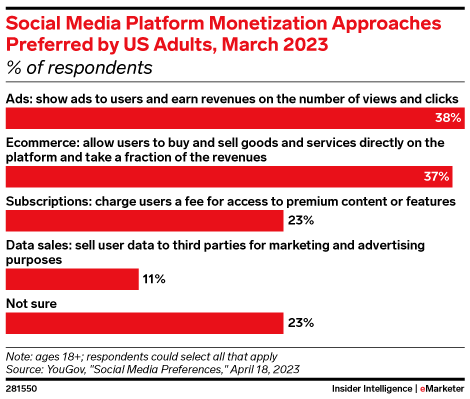Table of Contents
Meta is redefining the social media experience in Europe with the introduction of adfree subscriptions for Facebook and Instagram. Amidst intense antitrust scrutiny and a landscape thirsty for change, these new offerings emerge as a bold move to satiate the modern user’s craving for uninterrupted online browsing.
As Europe debates the cost and impact of subscription models, Meta’s new plan reflects a worldwide shift towards paid features initiated by leading tech companies. The stage is set for a deep dive into Meta’s subscription-based pivot—potentially a new chapter in the narrative of social media.
Did you know that NeoReach runs world-class influencer marketing campaigns? Check out our case studies here!
Setting the Stage: European Regulations and Meta’s Subscription Strategy
The strategic development of Adfree Subscriptions for Facebook and Instagram is in direct response to the evolving regulatory demands, particularly in anticipation of the Digital Markets Act set forth by the European Union.
European regulators are tightening their grip on digital markets, enforcing stricter rules that large tech companies must navigate. In reaction to these regulatory changes, Meta is adapting its services. This includes a reduction in some areas while introducing ad-free subscription options, which may better meet the new regulatory framework.
The pressures of the EU’s regulations have significant implications for Meta’s operational and financial models. EU regulators are not merely adjusting existing rules but are restructuring the digital marketplace, pushing companies like Meta to innovate their approach to revenue and user services.
Meta’s adaptation to European regulations hints at a growing trend in social media, prioritizing user preference and privacy in its business model. This could very well be an early indicator of a more significant global shift in how social media platforms operate and generate revenue.
The Genesis of Adfree Subscriptions
Meta’s latest venture into subscription services marks a significant shift for the platform. Offering an ad-free experience on Facebook and Instagram, this service caters to users looking for a seamless, uninterrupted browsing experience. With a simple subscription, the all-too-familiar flood of targeted ads gives way to a digital experience more focused on content and community.
Europe serves as the chosen launchpad for this initiative, a strategic move by Meta that acknowledges the continent’s stringent data privacy standards and the high premium its citizens place on digital privacy. This decision is not merely about tapping into a new revenue stream; it’s a tailored response to the unique market dynamics of the European Union.
At the heart of this strategic shift lies the pressure from European antitrust regulators, which has compelled Meta to innovate within the legal framework. Introducing ad-free subscriptions is a proactive attempt to realign the company’s offerings with the EU’s rigorous data privacy and competition policies, demonstrating Meta’s commitment to adapting its business practices to meet the stringent demands of its diverse global user base.
@han_selah Meta is now charging a subscription fee to use Instagram and Facebook 😳 I just went onto Instagram and this modal popped up. Is this something you guys would pay for? It’s double the price than Amazon prime #hanselah #meta #metasubscription #instagramsubscription #adfree #facebooksubscription #metaadfree
Subscription Details and Pricing
Meta’s foray into adfree subscriptions for Facebook and Instagram comes with a clearly defined price tag aimed at users seeking a cleaner, uninterrupted social media experience. The cost structure is tiered, ranging from $11 to $15 per month, with a varied pricing strategy that seems to take local economic factors into account. However, Instagram is no stranger to developing creative new revenue streams; check out this NeoReach blog to learn more.
For this monthly fee, subscribers gain a more streamlined social browsing landscape—free from the ads that punctuate news feeds and stories. However, it’s not just about what’s removed; it’s also about what’s added. Subscribers to the adfree service are promised not only a lack of ads but also a quality-of-life improvement in their daily interactions with both platforms.
The subscription links both Facebook and Instagram, acknowledging the intertwined usage patterns of their user bases. This bundled approach reflects an understanding of the modern social media user—one who navigates between platforms seamlessly and expects a coherent experience throughout.
By opting for this adfree service, users are not only voting with their wallets for a less ad-driven experience. Still, they are also participating in a larger shift within the social media ecosystem—one where the option to pay for privacy is becoming an increasingly valuable commodity.

Comparison to Twitter’s Subscription Model
Meta’s rollout of ad-free subscriptions on Facebook and Instagram seems to parallel the strategy behind “Twitter Blue. These similarities align with a shifting trend in social media toward subscription revenues. Unlike Twitter, which couples fewer ads with added features, Meta is betting on a completely ad-free experience, possibly attracting those who prioritize uninterrupted use.
Nevertheless, consumer response to such models is still a variable. Twitter’s subscription service has seen only a 0.2% uptake among U.S. users, suggesting a lack of perceived value for the price. Likewise, Twitter users have expressed a strong distaste for Twitter Blue as the platform’s algorithm caters to Blue users who spread misinformation and break rules. This lukewarm reception could be indicative of the challenges Meta may face, as users might not be convinced to pay for ad-free scrolling.
While Meta is steering towards what seems to be a user-centric approach, actual user engagement will be the true test of this strategy. Twitter’s tepid success with subscription models may signal caution for Meta’s similar endeavor. However, if Meta’s service fails to appeal to users, it will highlight the challenges of matching business plans with consumer desires. Twitter Blue subscribers have dealt with many issues, including delayed ad revenue payout- learn more here!
As these platforms experiment with these new revenue models, the broader implications for social media are clear: the industry is cautiously stepping away from a sole reliance on ad revenue. This transition hints at a future where user choice and preferences are of utmost importance, potentially leading to a more diversified and user-centric social media landscape.
Final Thoughts
Meta’s recent introduction of adfree subscriptions for Facebook and Instagram marks a turning point for user experience in Europe. With ad-ridden feeds becoming a point of contention for users and regulators alike, Meta’s new service offering proposes an alternative route, one less traveled but increasingly in demand.
As Meta charts its course through the complexities of European regulations and user expectations, its adfree subscriptions may well serve as a beacon for the future of social networking. In this future, choice and privacy are integral to the industry.
Looking to run an epic influencer marketing campaign on social media? NeoReach has the best experience in creating viral campaigns that convert on social media. Sign up here!























